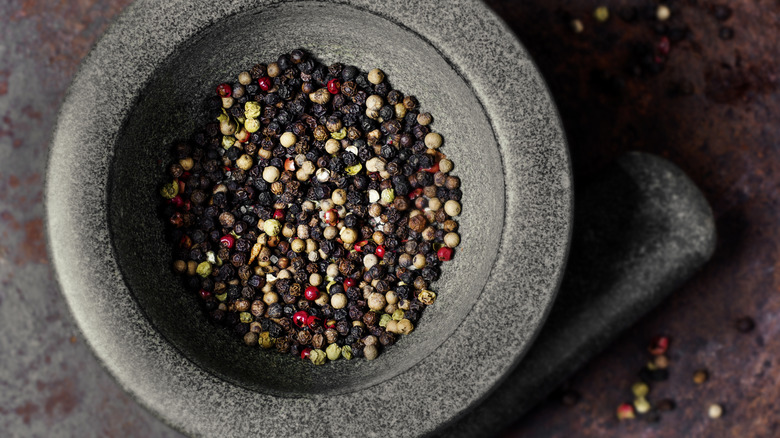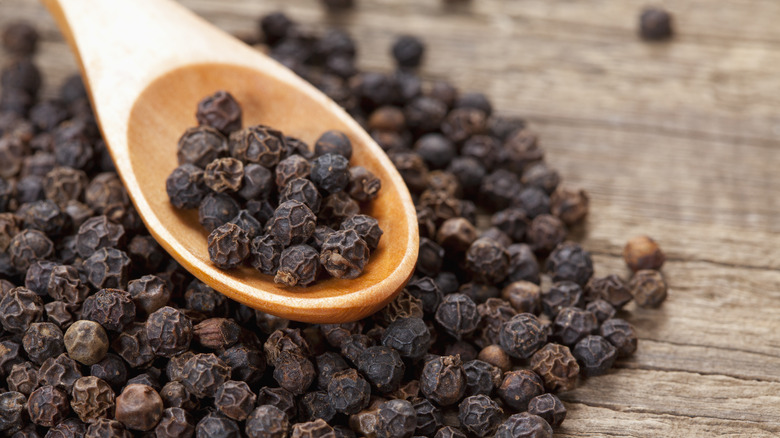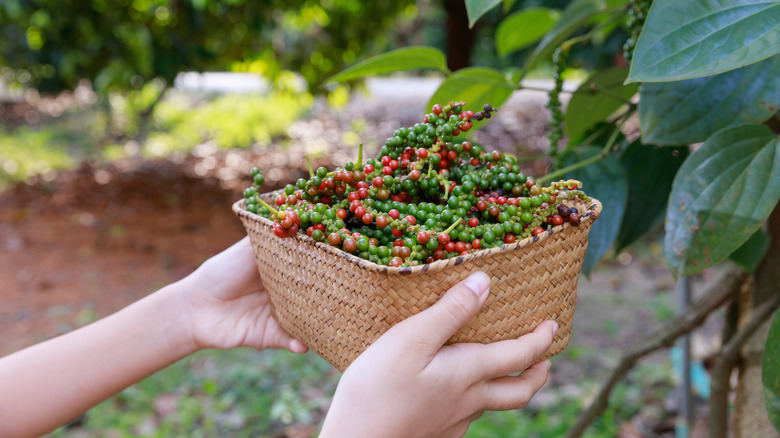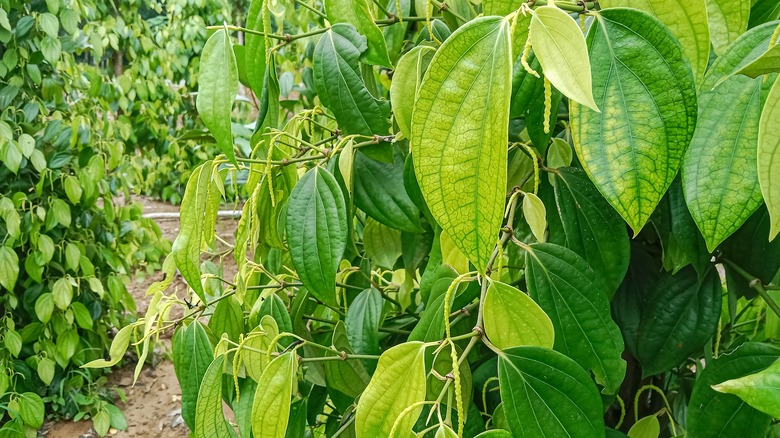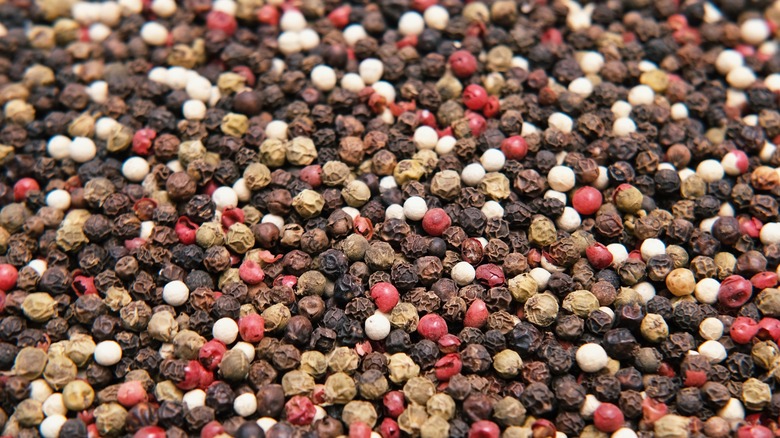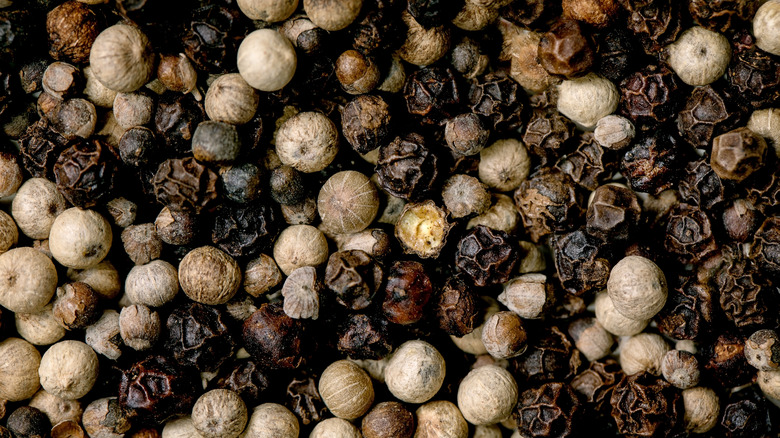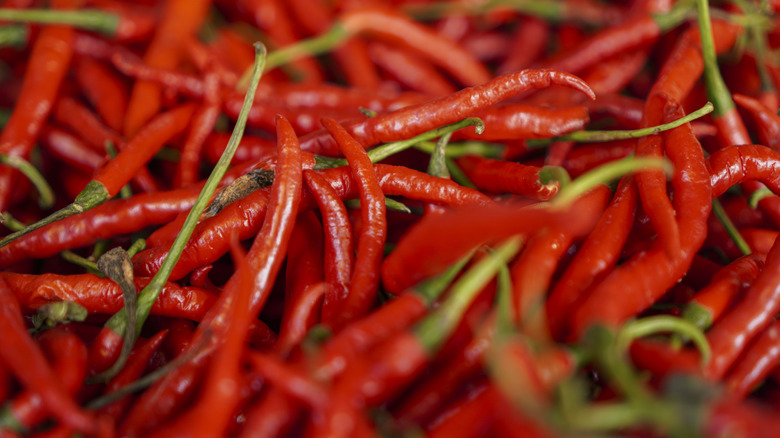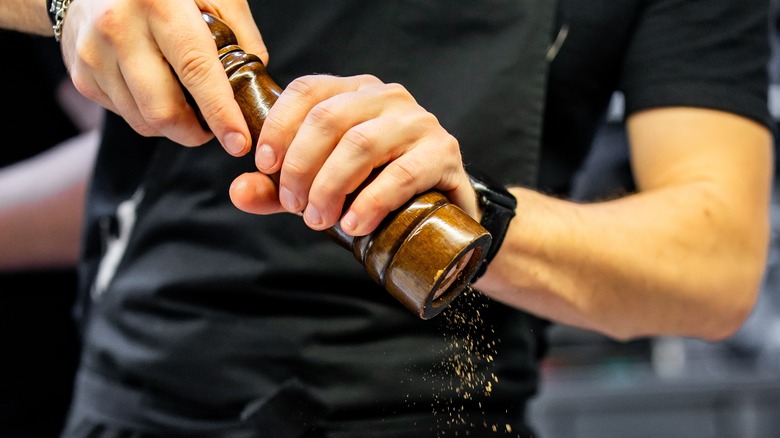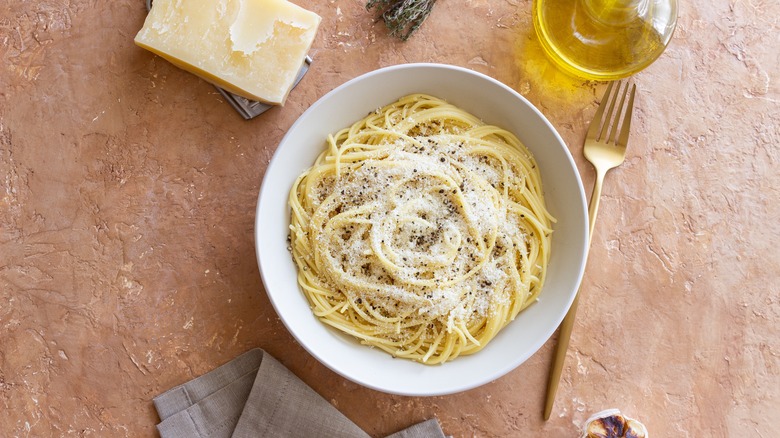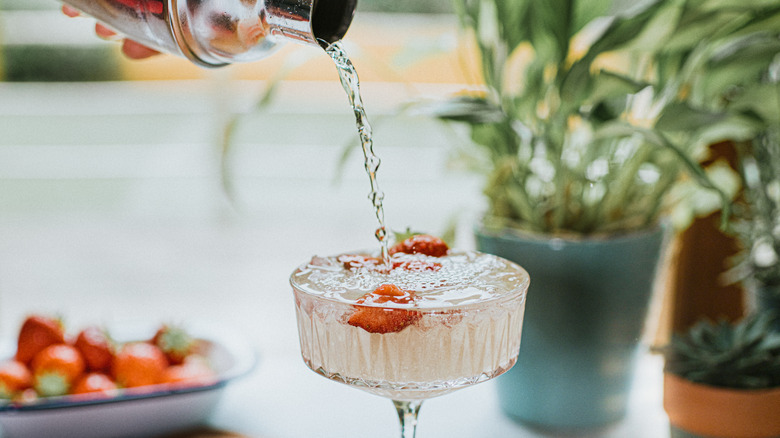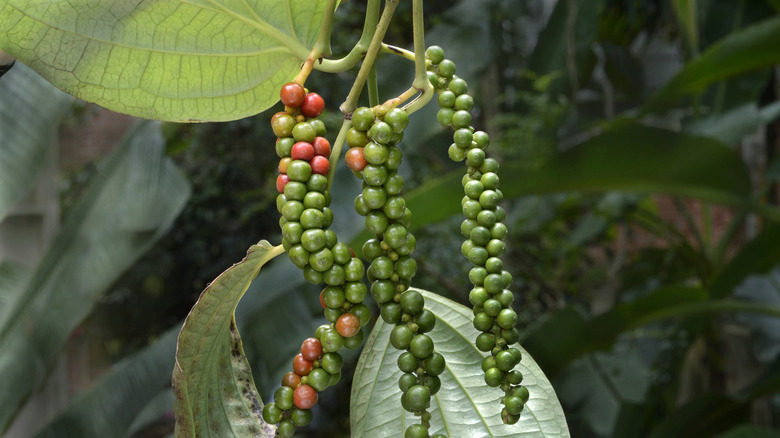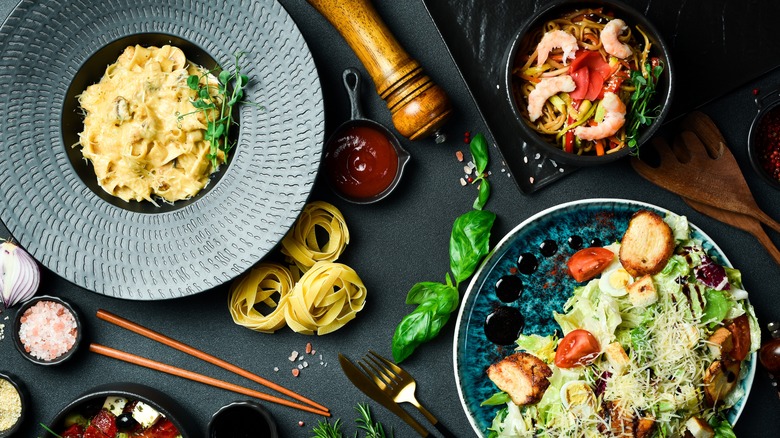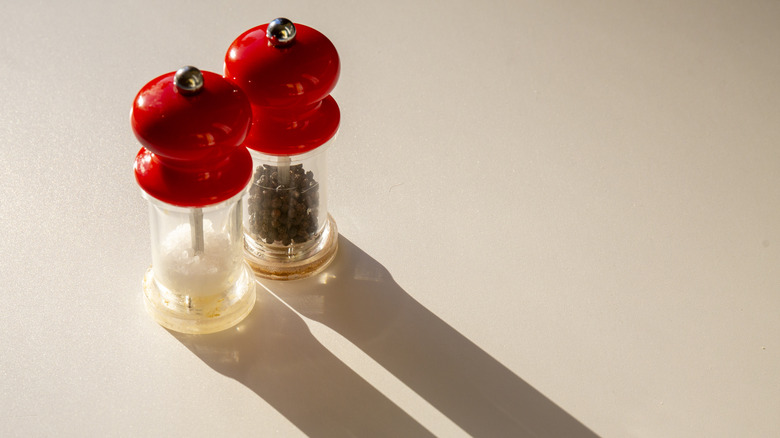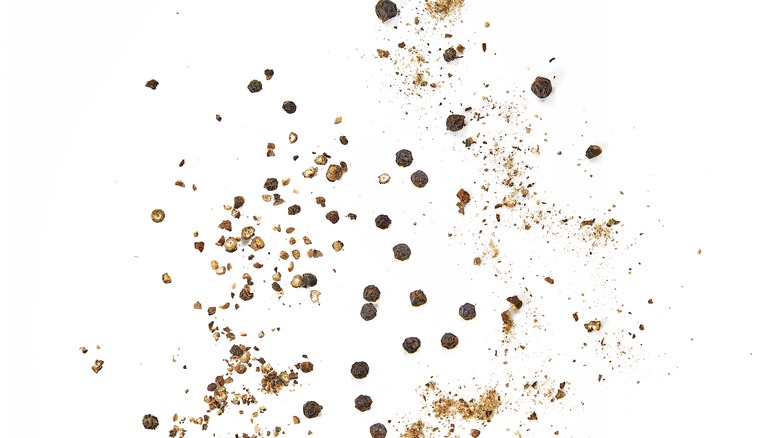Everything You Wanted To Know About Black Pepper But Were Too Afraid To Ask
Pepper seems like a basic ingredient, given its ubiquity on kitchen counters and diner tables. But buying pre-ground pepper and sprinkling it on your eggs is only the tip of the iceberg when it comes to this ancient spice. Not only does "black gold" have a fascinating age-old history, but the many varieties of pepper (think white, red, and green) are actually all from one fruit. In the same way that tea (Camellia sinensis) can be made into white, green, black, and oolong, pepper has many faces and preparation methods — kind of a heavy burden for the humble companion to salt.
For that reason, home chefs who are interested in finding the best ingredients for their dishes would do well to learn more about sourcing, grinding, and using black pepper. A few small adjustments can make a big difference when it comes to the flavor and complexity of your dishes.
What is black pepper?
It is far from the hottest pepper in the world, but black pepper is nevertheless a spicy flavor that we have come to love. And although we may all recognize it on the dinner table, its agricultural origins are more of a mystery.
Black pepper (Piper nigrum) is a climbing vine in the Piperaceae family, which also hosts such well-known plants as Piper methysticum (the kava plant), Peperomia species (common but sometimes fussy houseplants), and Piper cubeba (used medicinally and to make cigarettes in Southeast Asia). Black pepper is native to the Malabar Coast of India in Kerala, but quickly spread to Southeast Asia and can be found growing around the world in warm, humid regions that mimic its birthplace. Today, the largest producer of pepper is Vietnam.
What we know as the peppercorn is the drupe of the plant. (A drupe is like a berry but with a fleshier outside and firmer interior.) It grows in hanging, somewhat grape-like clusters on the vine. When young, it is bright green, but it turns red as it ripens.
A brief history of pepper cultivation and use
Pepper was first cultivated in Ancient India, and then rapidly spread in other parts of Asia as people discovered its culinary and medicinal uses. Indeed, the word pepper comes from the Sanskrit word for long pepper, "pippali." From this stemmed the Greek word "peperi," and "piper" in Latin. In addition to reaching Ancient Greece and Rome, pepper also made its way to other parts of the ancient world. It was so valuable at one time that it was used as a medium of exchange, used to pay tributes.
Today, it has become one of the most widely used spices in the world. It is represented in a huge variety of cuisines, from Italian (think bucatini cacio e pepe) to Chinese (spicy pepper steak) to epic snack foods (baked chicken skin with paprika and black pepper). With its delightful pungency and citrusy tang, black pepper is a kitchen staple for a reason.
How black pepper is produced
Pepper plantations feature large poles or ropes to support this climbing plant, which anchors itself to them using short rootlike nodes like other climbers do. It will also grow as a bush. The pepper plant self-pollinates, producing a drupe with a fleshy outer covering and a hard interior seed. When ripe, the seed is red, but it becomes black when it is dried.
Interestingly, while wild plants are usually male or female, cultivated plants are bisexual, a word that was applied by scientists to plant species long before it became a common term to describe people's sexual preferences. In the botanical world, bisexual partly means self-pollinating, which may have arisen unintentionally as a desirable trait over thousands of years of breeding. After all, self-pollinating plants have reduced requirements as opposed to their counterparts whose male-female reproductive needs must be taken into account. The final treatment of ripe berries depends on the desired peppercorn color, as discussed below.
What's in a hue? Peppercorn colors
"Black" pepper actually needn't be black in color. The spice also comes in white, green, and red varieties. Depending on the color of the pepper, farmers may pick it at different stages of the ripening process. Also depending on the desired final product, they may soak it, remove the outer covering, or simply dry it.
For instance, red is left to fully ripen and dry on the vine before picking, then sold in its natural state or brined. Their higher sugar content does make them more likely to spoil, hence the brining. Green pepper is, as you might assume, picked when not yet ripe. It is freeze-dried before selling. White pepper is picked when ripe, then skinned. Note that although they look the same, the pink peppercorn is not actually from the Piper nigrum plant, but rather from another plant entirely: the Peruvian pepper tree (Schinus molle).
A peppercorn's colors aren't just for fun; they connote differences in flavor. For instance, white pepper is milder than black. If you're going to substitute one for another in a dish, be aware that the taste will change and be prepared to adjust as necessary. And for clever cooks who want the best, there are choices to make beyond color. Believe it or not, more than 600 varieties of black pepper exist, but you likely only have to choose between the three most common types: Black Tellicherry, Black Malabar, and Black Lampong.
The flavor of black pepper
Black pepper's famous flavor has been described in many different ways, including hot, biting, woody, piney, fruity, and citrusy. Although it does not carry the same heat as cayenne or chili, it can still leave the mouth feeling what some describe as prickly after getting a big hunk of it. (And if you've ever gotten some of it stuck in the back of your throat, well, IYKYK.)
The good thing about black pepper is that you can add heat without overpowering your food, as is more common with hot pepper varieties. It's a classic flavor for dressing up eggs, meat (such as black pepper steak), salads, and more.
The downside is that, if you're too cavalier, you'll find that black pepper is more than capable of swamping a dish on its own, which is why some chefs forego it completely. Whether or not you add it is up to you, but it's better to use a light hand and match the flavor of your pepper with your recipe.
Distinguishing true pepper from other types
Black pepper and chili pepper (Capsicum annuum) are not the same thing at all, but given their similar names and the fact that they both bring heat to dishes, home chefs can get confused about which to use when. Paprika is another type of pepper that bellies up to the bar, but it is simply another way to dry and prepare the regular chili plant (although it can also be made from mild bell peppers). Thus, a primer may prove helpful, especially since, aside from basic differences in color and heat levels, black and chili peppers have different flavor profiles that make them unsuited for substitution.
There are two main differences. First, black pepper hails from Southeast Asia, while chili peppers are an American food. (For instance, cayenne is native to Central and South America). Second, black pepper offers less heat but a more complex woody, piney, citrus flavor. Chili pepper is simply hot, without bringing a lot of flavor of its own unless it is smoked or otherwise altered.
It's important to understand the differences in all these options and not substitute them too freely for one another. If you're going to try a substitution, look it up online to see if it's possible and, if so, get the amounts right.
Grind sizes of black pepper
Many spices come in two main forms: whole and ground. Pepper is different in that it carries a lot of potential for flavor differences based on how finely you grind it. If you want it to blend into the background, you can grind it small, whereas if you want it to pop while finishing off a dish, you can grind it more coarsely.
It's not quite that simple, however. Depending on whom you ask, pepper actually has a number of different designations depending on the size of the grind. The smallest is referred to as fine or pure, followed by table grind, so named for its presence on restaurant tables across the Western world. (In some breakdowns, there is a shaker size between pure and table.)
Coarsely ground black pepper is the biggest grind (great for dressings), followed by cracked pepper, in which some of the peppercorn features are still visible. And then, of course, there are whole peppercorns. You can either purchase these to grind freshly yourself or use them whole in marinades, pickles, etc.
How to choose the best spices at the store
Choosing the best spices is relatively simple. Look for clearly labeled jars that don't contain anything other than whole or ground pepper. Check the best-by date, inspect the seal, and where possible, avoid low-grade store brands that obfuscate the origins of the product. Where possible, get whole spices and grind them yourself, as this will yield the freshest flavor.
Also, beware of fake spices. Yes, it's a thing, and no, it's not easy to spot when disingenuous purveyors mix dupes like papaya seed in with your peppercorns. However, there are a few ways to tell your pepper isn't pure. Real peppercorns should be dark brown to black (unless it is red, white, or green) without looking either weirdly bright or faded. Pepper should also emit an immediate distinctive smell when cracked. If you get it home and don't notice this, it either means the spice is old or fake, so get your money back.
How to grind your own peppercorn properly
Switching to freshly ground pepper can majorly change the flavor of your food, mainly due to how much fresher it is. Shockingly so, in fact. As soon as you grind the pepper, the flavor and aroma released by its essential oils begin to fade. Within 30 minutes, they are almost entirely gone, leaving you with a pale imitation of the freshly ground variety.
As such, if you can, it's always best to grind pepper yourself. The good news is that, unlike a more difficult spice (say, turmeric or cumin), it's quite easy to do. That's what the universal peppermill is for, and those with a good seal will keep the peppercorns inside fresh while they await their fate. If you like the taste of freshly ground pepper, then it's a good way to keep it on hand and ready to go.
However, if you want to grind lots of pepper at once for spice mixes or rubs, you can use a spice grinder, food processor, or blender to do so in big batches. This will likely prove fresher than store-bought ground pepper, even if it does risk losing much of the aroma if you don't use it immediately. If you don't have a spice grinder or appliance, you can also use a mortar and pestle or even put peppercorns in a Ziploc bag and bash them with a rolling pin. (This, btw, is an excellent trick for getting over a breakup.)
Common uses for pepper in the kitchen
So, how much black pepper should you be using? It's no use finding a straight answer online. Some sources say you're not using enough of it, while others say you're using too much of it. Who's a humble cook to trust? The best answer to this conundrum is to let go of your fear that you will either under- or over-spice your food and instead just go for it. You'll learn what works for you just by trying to move beyond the cracking-it-over-your-eggs-and-leaving-it-at-that approach.
Pepper is an awesome addition to otherwise plain Jane breakfast foods. For instance, Gordon Ramsay adds it to his hashbrowns to kick them up a notch (along with a bit of cayenne while he's at it). It's an important ingredient in Indian flavor profiles, so add it to your curries stat. You can also use it in cheddar biscuits, fish tacos, and roasted veggies, as well as the classic French steak au poivre (which simply means "with pepper"). If you don't already have a filled peppermill on hand for ready cracking, you should get one.
And before you assume pepper can never be used in sweet foods, think again. It makes a lovely and unexpected accompaniment to fruit in concoctions such as roasted strawberry and black pepper gelato. Believe it or not, it's also good in sweet buns, apple pies, and even chocolate chip cookies.
Black pepper cocktails are a thing
Pepper brings a nice zing to fruity cocktails, especially in summer, where it marries perfectly with the bounty of the warmer months. For those who don't want flakes of black pepper in their cocktails, there is a solution: black peppercorn simple syrup. This will give you that nice peppery bite without the grittiness. As a bonus, you can use the leftover peppercorns to give your next steak au poivre a nice sweet kick.
Once you've got your syrup in hand, it's time to get mixing. Use it to make beautiful cocktails in unique flavor combinations. For instance, blood orange and vodka get a nice punch from black pepper and apple cider vinegar, while strawberry and gin benefit from the addition of lime and soda water with that peppery flair. Now bring vodka back, but combine it with lavender simple syrup instead and grind fresh pepper into the drink for little pops of heat.
Growing your own pepper plant
Yes, you can grow your own pepper plant, though it's highly unlikely you'll be able to do so outdoors if you live almost anywhere in the continental United States. It needs hot, steamy jungle conditions that mimic those of its Indian origins. For those who live in Hawaii or Puerto Rico, though, it's possible to keep it as a year-round garden specimen. For those who don't, you can grow black pepper indoors given the right light conditions.
Assuming you want to grow it indoors, you'll find that pepper is only mildly fussy, requiring medium maintenance and watering. Make sure the plant has good drainage and feed it with a 10-10-10 fertilizer, watering deeply when it is nearly dry and then allowing it to dry out again. Otherwise, you risk root rot. Put your pepper plant somewhere it will get good sunlight, about four hours a day at minimum, and mist it regularly or use a humidifier.
Health benefits of pepper
Black pepper offers all kinds of health benefits. One of its primary compounds, piperine (which is responsible for its fiery taste), is an antioxidant that inhibits free radicals, the damaging compounds that can harm DNA and cause cancer. While human trials aren't yet underway, research in test tubes demonstrates that piperine may help to inhibit the growth of several different kinds of cancer cells. It is also an anti-inflammatory agent, helping to reduce swelling. Studies indicate it can even assist with wound healing via topical application, with some people attesting to its ability to stop bleeding from small cuts.
Black pepper has other beneficial properties as well. For instance, black pepper may strengthen your bones, boost your mood, regulate your blood sugar, reduce your appetite, and help you absorb nutrients. Eating it along with healthy, home-cooked meals (or simply cracking some over the top of your takeout) could therefore help you get more out of the ingredients you're already eating.
Storing black pepper to last
Black pepper lasts for a long time and will never go off or make you sick. (Actually, it has antimicrobial properties of its own, so it can even extend the shelf life of other foods.) However, it does lose its flavor over time, especially if stored improperly. In general, unopened pre-ground pepper will last three to four years, dipping to two to three years once opened. Peppercorns can last up to five years, while pepper in the freezer has a shelf life of one to two years.
Storing black pepper has the same requirements as most other spices: reduction of light, airflow, and moisture. It's always helpful to keep black pepper in a drawer if you can, to be able to remove it easily without having to dig through the cupboard. You should also keep your spices, including pepper, away from the heat of the stove, which can degrade them more quickly. If you want to maximize shelf life, buy whole peppercorns and only grind them as needed.
Nutritional information
Black pepper is a low-calorie spice, with only six per teaspoon. It also has no cholesterol and tiny amounts of fat and protein. It is high in nutrients such as copper, iron, calcium, potassium, phosphorous, manganese, selenium, zinc, chromium, and vitamins A, E, and K, as well as a range of B vitamins. Because it packs such a strong flavor in small amounts, you'd have a hard time eating enough of it to create any kind of discernable caloric impact. That makes it a great flavoring agent as an accompaniment to salt and in place of more calorie-heavy additions to your cooking.
However, you should be somewhat careful, as black pepper (in any color form) can be irritating to your stomach lining. Although it isn't a risk to your long-term health in the same way as salt, it can make you feel sick or cause heartburn if you consume too much of it. If you start to feel such symptoms, back off your usage.
